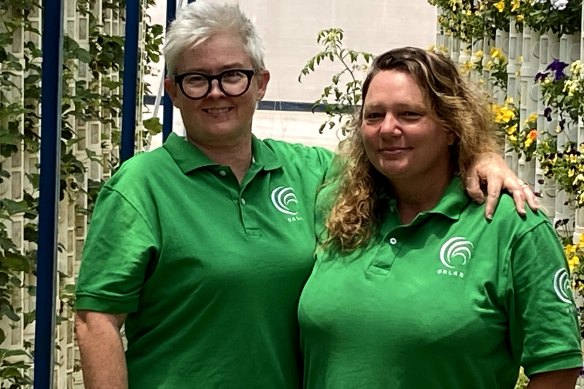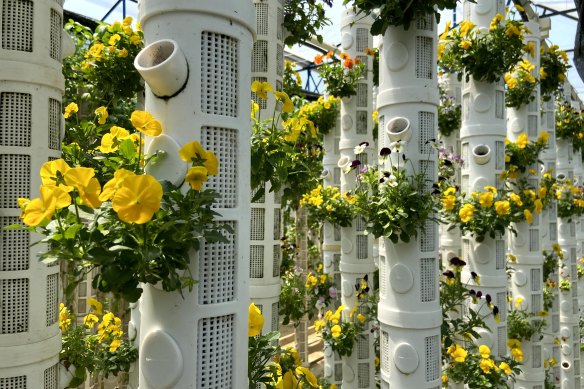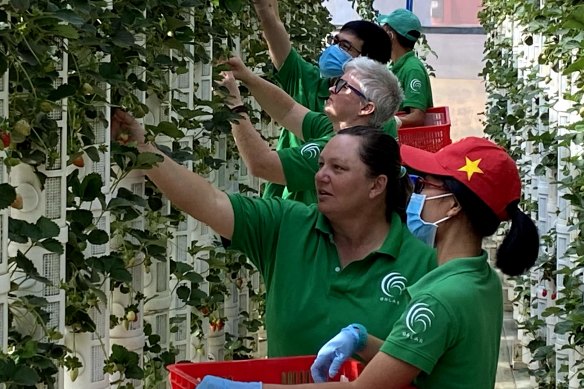This was published 2 years ago
Opinion
The secret rock that could help feed the world and the ‘nerdy’ Australian scientist who discovered it
Elizabeth Farrelly
Columnist, author, architecture critic and essayistFood. In the end our survival depends on our capacity to feed ourselves without destroying the planet. As our numbers increase, this seems nigh impossible. But a system invented by a NSW woman and trialled in Vietnam looks set to revolutionise the whole food-land-planet relationship – or, at least, buy us time.
Lyndal Hugo had a background in agroscience, a Sydney Uni PhD in environmental chemistry and a post-doctoral fellowship on pesticide residues in South-East Asian food chains. It made her, she says, “a nerdy scientist – way over-educated and practically useless”. Except for three things – an idea, a piece of luck and a dream.

Orlar co-founders Lyndal Hugo and Amanda Cornelissen Credit: Ngô Quang Thịnh/AFR
The luck was that, when working on environmental accounting for big mining and agriculture companies in Australia and China, she’d encountered a particular rock. (Exactly what rock remains a closely guarded secret.) The idea was that this rock, treated in particular ways (also secret), had extraordinary potential not in mining but as “a home for microbes”. And the dream? It was to change the world.
Specifically, it involved growing fresh leafy vegetables that were safe, sustainable, nutritious, affordable and ethically produced with no single-use plastics, chemical residues, wastewater or carbon emissions. Oh, and to make enough money doing it to render the model replicable – hence, to change the world.
Now it seems she, via her company Orlar, is almost there. Rewind several years. Hugo yearned to do something meaningful. Her wife, Amanda Cornelissen, said: “You’ve got 12 months to go play.” But funding was hard to come by. “Women have 2 per cent the chance of men of raising capital,” Hugo reflects without bitterness. So, she and Cornelissen headed to Ho Chi Minh City. It was meant to be six months. That was five years ago.
“Never take a dream to the developing world,” says Hugo now – though with obvious love for the place. It was $600 for two one-way fares home: “For years we never had more than that in the bank ... We lived in a tin shed with dirt floors, tipping a bucket over our heads for a shower.” Now, government grants pile up and investors beat a path to their door.

Edible flowers growing on Orlar pods.Credit: Ngô Quang Thịnh /AFR
So, what’s the system? It’s not indoor agriculture. Hugo is clear about that. The difference is that indoor agriculture normally requires huge energy inputs for temperature control and lighting. It requires a strictly controlled environment – workers in hazmat suits – to limit disease, which is virtually impossible in a developing country. And it either has high carbon emissions or, if solar-powered, the solar panels occupy large areas of land, with concomitant biodiversity impact.
Orlar’s system – now a business that supplies Vietnam’s top 200 restaurants and most middle-class supermarkets – uses greenhouses, with light and warmth provided gratis by the sun. The key, though, is in the secret rock. It has three seemingly magical properties: enormous thermal mass, the ability to retain water against the pull of gravity and an affinity for microbes.
It starts with chemistry – the rock’s pH and its liking for long-chain anionic molecules. Just as important, though, is how it’s treated. Ground into the right mix of sizes to optimise hydraulic conductivity, transpiration and gas exchange, it is infused with trillions of microbes, from 81 different species, which are encouraged to form a biofilm.
These microbes – the biotech – are hugely expensive. What’s clever about this particular microbial soup, though, along with the water-holding and thermal insulation of the rock, is that it succours only beneficial bugs. The substrate is constantly subjected to microbial tests – but, says Hugo, “we can actually put e.coli and salmonella inside our materials, and they don’t survive”.

Harvest time at an Orlar farm in Da Lat, in Vietnam’s central highlands. Credit: Ngô Quang Thịnh/AFR
This means the rock (unlike vermiculite or rockwool) is not dumped after each growth cycle but can be reused indefinitely. This gives the microbes, too, a long and useful life – rendering them very economical.
Because such a microbe mix generates ultra-healthy plants, no chemicals are applied and only minimal amounts of organic-certified pesticides and synthetic fertiliser. No hazmat suits, either – just local people in T-shirts and jeans. The thermal qualities of the rock mean that almost no heating or cooling is required – energy use per kilogram is less than 1 per cent of other intensive agriculture. Water use is minimal and greenhouse gas emissions net-negative. The yield, meanwhile – lettuce, edible flowers, tomatoes, strawberries, herbs – is clean, fresh, local and cheap.
This is important because South-East Asia has the world’s highest rate of residue-induced cancer. “Clean” imported food is flown in at huge cost and huger emissions; the poor get sick. Further, roughly half of Vietnam’s food production comes from the Mekong Delta, which is gradually sinking due to climate change and salinating due to the construction of hydro-dams up-river in China and Laos.
Mekong rice uses 2500 litres of water per kilogram; Orlar food uses just 30 litres – and with four times the revenue per kilogram. Also, being vertical farming, with 20 plants grown in each two-metre-high stack or “pod”, it is extremely space-efficient.
Critically, the thermal qualities of the rock allow temperate vegetables to be grown in “hostile” climates such as the Mekong, providing massive climate-adaptation and jobs with minimal water and land. Plus, as a company led by women, and 89 per cent staffed by women, it transforms lives and families.
Hugo chuckles at herself. “Two peri-menopausal women head to the jungle and go, ‘Let’s change the world.’”
Is it mad? As we confront mass climate-induced migration, I say, what could be saner?